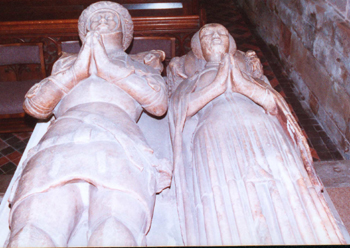

1450 - 1486 Humphrey Stafford
1488 - 1521 Sir Edward Poyning
1521 - 1545 Humphrey Stafford
1545 - 1548 Sir Humphrey Stafford
1548 - 1574 Humphrey Stafford
1574 - 1595 John Stafford
1595 - 1606 William of Blatherwyke
1606 - 1637 William Stafford
1637 - 1638 Edward Stafford
1638 - 1643 Charles Stafford
1643 - 1643 William Stafford
1643 - 1677 Henry Stafford


In 1450 Humphrey Stafford and his brother John (The Archbishop) lead an army against the Kentish rebellion from Jack Cade, his complaint being that "the system of tax collection was unjust and extortive". The rising was in no sense revoulutionary, but a demand for a reform of the existing order. The King replied two days later by commanding the gathering to disperse. It did not, and so the King marched his army through London to give battle to the rebels, but found their camp at Blackheath deserted. Cade had moved on towards Sevenoaks, and where the road ran narrow prepared an ambush. Once the royal army was caught in the bottleneck the rebels fired their arrows ,followed by a fierce charge in which both Sir Humphrey Stafford and his brother were killed. The King panicked and left the city undefended , Cade saw an oportunity to invade the abandoned city and marched back to Blackheath.
The Aldermen debated that the best course of action was to allow Cade to cross the bridge into the city as this would be less destructive than a forcible entry. When the gates were opened Cade rode through 'like a lordly captain' wearing the valuable armour taken from the body of Sir Humphrey Stafford. After conferring with the Lord Mayor Cade returned back over the bridge and established his headquarters. There were periods of immobility , but eventually another battle was fought on the bridge between Cades men and nobility of the city , rich aldermen great merchants and archers who had returned from France. Neither side gave way , and the dead and wounded obstructed the fighting,. Cade then managed to set fire to the houses near the drawbidge and the flames swept across the street, at this point Lord Scales decided to use a new-fangled weapon from the Tower, the cannons fired stone balls which rarely found their target but managed to induce terror from the booming noise they made. By morning combat had stopped and a flag of truce raised. Negotiations were proposed, but the high clergy and crafty politicians managed to finally dupe Jack Cade into accepting The 'Charters of Pardon'.
The King announced a writ of outlawry against Cade with a price of 1000 marks put on his head ,and 5 marks for each head of his followers. Eventually Jack Cade was cornered and killed in a state of hunger and exhaustion. His quarters were displayed at Blackheath, Salisbury,Norwich and Gloucester as a warning to dissidents.
BATTLE OF AGINCOURT
Humphrey Stafford previously fought in this battle in 1415. Henry V shared with his forefathers the ambition to add France to his domains. England had been at war with France intermittently since 1340. Today we know this series of conflicts as the Hundred Years War. The battle took place in Agincourt on 25 October 1415, Henrys superior force in a strategically brilliant operation, destroyed the French army to win the battle.


"The rebels are in Southwark; fly my lord!
Jack Cade proclaims himself Lord Mortimer,
Descended from the Duke of Clarence house,
And Calls your Grace usurper,openly,
And vows to crown himself in Westminster.
His army is a ragged multitude
Of hinds and peasants, rude and merciless;
Sir Humphrey Stafford and his brothers' death
Hath given them heart and courage to proceed.
All scholars, lawyers, courtiers, gentlemen,
They call false caterpillars and intend their death."
"Rebellious hinds, and filth and scum of Kent,
Mark'd for the gallows, lay your weapons down;
Home to your cottages, forsake this groom:
the king is merciful, if you revolt."
William Stafford
"But angry, wrathful, and inclined to blood,
If you go forward; therefore yield, or die".
Cade
"As for these silken-coated slaves, I pass not:
It is to you, good people, that I speak,
Over whom, in time to come, I hope to reign;
For I am the rightful heir unto the crown".
in 1488 The Manor of Milton Keynes is granted to Sir Edward Poynings